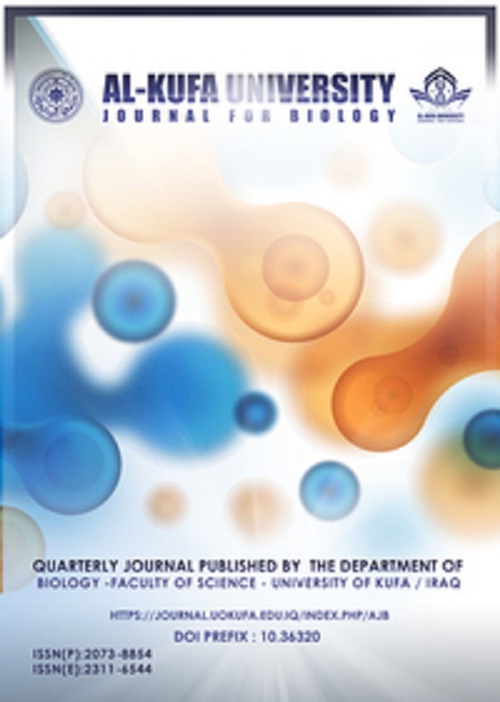Cytotoxicity Effects of Azithromycin and Curative of Garlic on Sperm Mortality and Testicular Tissue of Albino Male Rats
DOI:
https://doi.org/10.36320/ajb/v15.i2.13330Keywords:
Azithromycin, Garlic, testicular damage, testisAbstract
The current study aimed to identify the adverse effects of azithromycin drug and the protective role of garlic in cytotoxicity tests that included sperm deformation and histological changes in testes tissue of male albino rats. Twenty-four mature male rat animals (Rattus norvegicus) were used in the present study, their age was (2.5 – 3) months, and their weight ranged from 148 to 280 gm they were divided into four groups as follows:
The first group was the control group contained four rats and was administered distilled water only. In contrast, the second group containing four rats was administered garlic at 480 mg/kg body weight. The third group included eight rats, was administered Azithromycin at the dose of 500 mg/kg body weight. The fourth group contained eight rats, and Azithromycin was administrated at 500 mg/k mg+ garlic at 480 mg/kg body weight. The groups were treated with Azithromycin and garlic daily. The results recorded a significant increase (p≥0.05) in sperm head and tail deformation rate in the group administered Azithromycin + garlic compared with the control groups that were administrated distilled water and garlic. Furthermore, the results reported a significant decrease (p≥0.05) in sperm head and tail deformation rates in the group administered Azithromycin + garlic compared with the only Azithromycin administered group. Moreover, the study indicated histological changes in testes tissue included degenerative changes represented by depletion of the spermatogonial cells (some seminiferous tubules appeared with one or two layers of spermatogonia) in the group that was administered Azithromycin compared with the control group, which was administered distilled water and garlic. In addition, the study indicated slight histological changes in testes tissue compared with standard testes architecture, somniferous tubules with the maturation of spermatogony, and sperms inside the lumen in groups administered Azithromycin and garlic compared with control groups, which were administered distilled water and garlic Finally, the findings showed a reduction in histological changes in testes tissue in the group that was administered azithromycin+garlic compared with the group that was administered Azithromycin only..
Downloads
References
Doan, T., Hinterwirth, A., Arzika, A. M., Cotter, S. Y., Ray, K. J., O’Brien, K. S., ... & Lietman, T. M. (2018), Mass azithromycin distribution and community microbiome: a cluster-randomized trial. In Open forum infectious diseases August. (Vol. 5, No. 8, p. ofy182). US: Oxford University Press. https://doi.org/10.1093/ofid/ofy182
Echeverría-Esnal, D., Martin-Ontiyuelo, C., Navarrete-Rouco, M. E., De-Antonio Cuscó, M., Ferrández, O., Horcajada, J. P., & Grau, S. .(2020). Azithromycin in the treatment of covid-19 a review. Expert review of anti-infective therapy, 1-17. https://doi.org/10. 1080/14787210.2020.1813024
Oliver, M. E., & Hinks, T. S. .(2020). Azithromycin in viral infections. Reviews in medical virology. e2163. https://doi.org/10. 1002/rmv.2163
El-Sayed, M., Kandiel, M., & Ebied, D. .(2017). Changes in reproductive organs, semen characteristics and intra-testicular oxidative stress in adult male rats caused by Azithromycin. International Journal of Pharmacology and Toxicology. 2017 . 5(2), 72– 79. doi: 10.14419/ijpt.v5i2 .7778
Shang, A., Cao, S. Y., Xu, X. Y., Gan, R. Y., Tang, G. Y., Corke, H., ... & Li, H. B. .(2019). Bioactive compounds and biolo -gical functions of garlic (Allium sativum L.). Foods. . 8(7), 246. https://doi. org/ 10.3390/foods8070246
El-Saber Batiha, G., Magdy Beshbishy, A., G Wasef, L., Elewa, Y. H., A Al-Sagan, A., El-Hack, A., ... & Prasad Devkota, H. .(2020). Chemical constituents and pharmacological activities of garlic (Allium sativum L.): A review. Nutrients. . 12(3), 872. https://doi.org /10. 3390/nu12030872
Seed J, Chapi RE, Clegg ED, Dostal LA, Foote RE, Hurtt ME, Klinefelter GR, Makris SL, Perreault SD, Schrader S, Seyler D, Sprando R, Treinen K A, Rao Veerama -chaneni DN, Wise LD: .(1996). Methods for assessing sperm motility, morphology, and counts in the rat, rabbit, and dog: a consensus report. Reprod Toxicol. . 10 (3): 237-244. 10.1016/0890-6238(96)00028-7. https://doi.org/10.1016/0890-6238(96)00028-7
Bancroft J. and Stevens A. .(1999). Theory and practice f Histological Technique .4th .New York : Churchill Liingstone 1999,113-118. https://doi.org/ 10.1111/j. 1365-2559..tb00755.x
Chi-Gunchzhi, U. A., Omelich, E. V., Pchelina, K. E., Barannikov, S. V., Baldanov, E. V., Shikulskiy, A. S., ... & Tseluyko, S. S. .(2017). The effect of Azithromycin on sperm motility and quantity of spermatozoa. Амурский медицинский журнал. 2017. (4 (20)), 13-14.DOI: 10.22448/AMJ. 4.13-14
Kandiel, M., & Ebied, D. D. I. A. .(2017). Changes in reproductive organs, semen characteristics and intra-testicular oxidative stress in adult male rats caused by Azithromycin. International Journal of Pharmacology and Toxicology. . 5(2), 72-79. doi: 10.14419/ijpt.v5i2.7778
Jassab, H. K., Alghanimi, Y. K., & Alsafy, A. H. M. .(2021). effect of Azithromycin on some genetic parameters and protective role of vitamin c in male white rats. docid: https://connectjournals.com/03896..21.4789
Ajayi, A. F., & Akhigbe, R. E. (2020). Staging of the estrous cycle and induction of estrus in experimental rodents: an update. Fertility research and practice, 6(1), 1-15.
Abeer, M. N. H.. (2015). The protective effect of some natural antioxidants against Azithromycin induced testicular dysfunction in rats. American International Journal of Contemporary Scientific Research. . 2(5), 39-40.
Kumar V, Harjai K, and Chhibber S. .(2008). Effect of clarithromycin on lung inflammation and alveolar macrpghage function in Klepsiellapenumoniae B5055-induced acute lung infection in Balb/C mice.J Chemother. . 20:609-614. https://doi. org/10.1179/joc.2008.20.5.609
Lindstedt, S., Wlosinska, M., Nilsson, A. C., Hlebowicz, J., Fakhro, M., & Sheikh, R. .(2021). Successful improved peripheral tissue perfusion was seen in patients with atherosclerosis after 12 months of treatment with aged garlic extract. International Wound Journal. . 18(5), 681-691. https://doi. org/10.1111/iwj.13570
Khan, M. S., Qureshi, N. A., Jabeen, F., Wajid, M., Sabri, S., & Shakir, M. .(2020). The role of garlic oil in the amelioration of oxidative stress and tissue damage in rohu Labeo rohita treated with silver nanoparticles. Fisheries Science., 86(2), 255-269. https://doi.org/10.1007/s12562-020-01403-7
Sajitha, G. R., Augusti, K. T., & Jose, R. .(2016). Prophylactic effects of garlic oil and onion oil fractions as compared to vitamin E on rats orally fed with lead acetate solution. Indian Journal of Clinical Biochemistry. .31(3), 260-269. https://doi. org/ 10.1007/s12291-015-0526-9
Downloads
Published
How to Cite
Issue
Section
License
Copyright (c) 2023 Shaimaa Mohammed Ali Jasim

This work is licensed under a Creative Commons Attribution 4.0 International License.
which allows users to copy, create extracts, abstracts, and new works from the Article, alter and revise the Article, and make commercial use of the Article (including reuse and/or resale of the Article by commercial entities), provided the user gives appropriate credit (with a link to the formal publication through the relevant DOI), provides a link to the license, indicates if changes were made and the licensor is not represented as endorsing the use made of the work.












